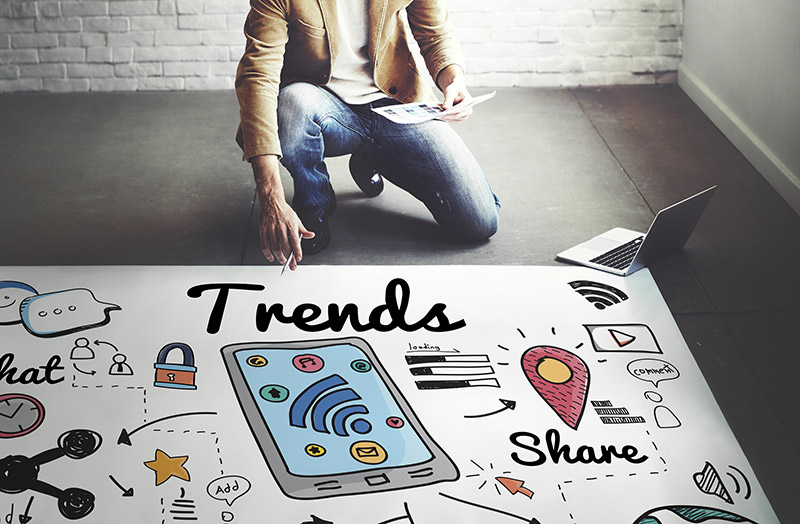The CPG Industry Trends of 2018 That Brands and Retailers Must Prepare For
There was a time when both consumers and industry experts believed that the retail sector was safe from the impact of increasing online sales. CPG brands appeared to be firmly attached to local brick and mortar shelves. That, however, is no longer the case as access to rapid shipping, curbside pickup, and mobile shopping have impacted every industry revolving around consumer packaged goods.
As recently as 2013, online sales of CPG products accounted for as little as 1% of total web sales revenue; however, it’s anticipated that by 2025 that will jump to 20%. The widespread use of online ordering, coupled with a growing consumer dependence on technology, has led to a major shift in how consumers make purchases. Emerging CPG industry trends for 2018 will require brand managers to shift the way they approach marketing by focusing on how they reach out to consumers in the digital space, as well as on how they advertise in-store and on shelves.
Amid this change lies opportunity, however. Our global marketplace has created an environment where CPG brands no longer have to think locally—or even nationally. Instead, they are able to successfully connect with consumers in brand new global markets never open to them before. Brand managers must capitalize on the digital 2018 CPG industry trends by gleaning insights from companies who have been early adopters of the digital forward march—and by leveraging mobile and web-based tools to understand and influence modern buyer behavior.
A Newly Globalized Marketplace: The Top CPG Industry Trend of 2018
In the past, CPG brands were limited to the consumer segments local to them and, as a result, focused the bulk of their marketing attention there. However, the most influential 2018 trend in the CPG industry is access to new, emerging markets of consumers. The internet now allows brands to get in front of millions of consumers that have not, in the past, been a marketing consideration, meaning there is a need for realigning marketing strategies in order to increase market share.
This was the case for Nestle when they chose to roll out their offerings in China’s ready-to-drink coffee market. The company quickly realized that Chinese consumers were not as willing to spend money on this product as American consumers—the price had to be right. The company reduced their costs by 30% by creating a supply chain within China and passed that on to the consumers. This decision allowed them to grab a market share in China, where they continue to be leaders in the ready-to-drink coffee market.
Before Nestle entered the Chinese market, they had, of course, done their research. However, until they were directly operating in the market, they couldn’t definitively predict sales. By tracking consumer behavior, however, they were able to adjust their strategy and successfully align their product with the needs of the Chinese consumer.
CPG brands, then, hoping to jump on the industry trends of 2018 by growing into new digital and global markets must adapt their advertising to genuinely speak to a vast pool of consumers based on geographic segments. The key takeaways for digital marketing and brand managers are:
Understand the new market:
As business goes global, you must be prepared to segment your marketing to focus on what’s important to consumers in different regions. In the US, consumers who drink Nestle’s coffee products are looking for a quick and easy ‘pick me up’. In China, the consumers were more focused on price. Understand what’s important to consumers in a given market and you’ll be able to cater to them. While that may be the price point, brand perception and quality can also be major converters as well.
Establish local contacts:
While the internet has allowed CPG brands to globalize at a rate never achievable before, the need to have a local presence still has not changed. Establish contacts in the local market when going global so you can continue to meet specific cultural and regional consumers needs.
Don’t anchor to a specific plan:
Nestle did research on what price points Chinese consumers found acceptable in their segment, but, in the end, that research didn’t align with the actual buyer behavior. They could have chosen to pull out of the market; instead, they shifted their plan to focus on what was important to those consumers. By reevaluating their position, they turned the push into the Chinese market into a success story simply by recognizing what was most important to consumers and then capitalizing on it.
Trending in 2018: An Increased Need for CPG Brand Connections
The adage used to be “The customer is always right.” However, in today’s digital marketplace, it seems that the most relevant adage is now closer to, “The customer is always informed.” This is another significant trend that is going to change the way the CPG industry must think of marketing due to an increased importance placed on consumer connections. Consumers no longer only want information about a product; instead, they want to connect with the company behind it.
Most consumers used to only research high-ticket items. Due to the ease of garnering information online, however, many modern consumers research every purchase. In fact, it was estimated in one study that nearly one-third of all purchases, across all categories, were spurred by a recommendation on a digital platform.
Consider the case of Harry’s, an online shaving and razor start-up company. It was started by two hopeful entrepreneurs who bought a defunct factory and wondered what to do with it. Then, they realized that a solution-driven approach was one which could guide them. Consumers of both genders always needed razors. Ideally, they needed them at a decent price and on a consistent basis. That’s when the founders decided to fill that need. They opened their factory doors, and even their company books, and approached those consumers in a straightforward manner. They even went so far as to create a biography about their brand.
Initially, the strictly online brand didn’t have much of a following. But, eventually, that strategy of being genuine and open with consumers worked. Today, Harry’s is a $100 million company with a significant base of loyal, dedicated consumers. By letting consumers in on their company’s journey, they turned their razors into a lifestyle.
Companies can take tips from Harry’s to create a brand that truly speaks to, and connects with, consumers. The key takeaways are:
Share your story:
Every brand, whether established or new, has a story—and consumers want to connect with it. By encouraging consumers to interact with your brand, you create the relationship needed to keep them coming back.
See a need, fill a need:
Razors are a fact of life for men and women alike. By seeing that need and filling it in a convenient and interesting way, Harry’s created a niche presence for themselves within the market.
Never underestimate the power of word of mouth:
Much of Harry’s business can be attributed to their willingness to connect with consumers via social media and other online mediums. One satisfied customer told their positive brand story and created ten more customers. Get customers to want to share your brand’s message by showing them its human side.
Shoppers Seek Out Sustainability: An Ever-Growing Trend in 2018
The next big trend is one that was spurred by necessity: sustainability. Consumers want to purchase from brands that are environmentally friendly. This trend is particularly noticeable in the CPG industry. Per one study, it was noted that 81% of consumers are willing to sacrifice convenience and comfort to reduce their environmental impact. If those consumers are willing to sacrifice, they expect it from their brands as well. Often, brands don’t have to change the way they do business to achieve this, though. Instead, they just need to make their sustainability efforts more visible.
General Mills is one such company which has clearly stated its dedication to sustainability. The brand focused on reducing carbon emissions at its plants and is also spearheading clean label movements designed to minimize ingredients in foods in order to limit the need to source and transport these products. The company CEO, Ken Powell, reported that demand from employees and consumers is what led the brand to make a change, stating that customers “want to know that the company that makes [their] food shares [their] values.”
Sustainability will continue to be a growing concern for consumers, which is why companies need to be prepared to meet that need. This could require changing ingredients and packages, or an action as simple as making public commitments to reduce waste, water usage, and carbon emissions.
The key takeaways for CPG brands in 2018 are:
Share your customer’s values:
Modern consumers care about their impact on the environment and want to work with companies that share those concerns. Consider ways your brand could reduce its environmental impact.
Discuss your goals publicly:
General Mills made its announcement not as a means of tooting its own horn, but instead to double down on a private commitment. By publicly stating that they were planning to reduce their environmental impact, they made it clear that they were dedicated to the cause.
Encourage customers to participate as well:
Encourage customers to participate in sustainability efforts by taking their own small steps in improving the environment. Ask them to then share those stories with your brand. This creates a sustainability partnership between you and your customers which will help keep them engaged.
Tying the CPG Industry Trends of 2018 Together with Consistent Engagement
Globalization, sustainability, and consumer connections are the three major trends which will be prevalent for the CPG industry in 2018. A lesson that all brands can derive from these trends is that the CPG industry must find a way to create an ongoing dialog with consumers. Brands must be attuned to what consumers in new markets want. By connecting with and understanding consumers, brands can create an engaging story that will keep them invested in their products.
While brands may see the globalization of markets as a challenge, there is also great opportunity. Brands can reach out to consumers they never could have in the past through the digital marketplace.
Here are just a few ways your brand can communicate with consumers about those trends:
Create a social media presence:
Consumers demanding greater transparency need more opportunities to interact with your brand. About 22% of the world’s population uses Facebook and nearly 70% of your North American customers are on the platform. If they’re on the platform, you should optimizing your presence there as well. This step is an important part of brand transparency, as through social media you make your brand accessible. This is also a good place to drive sustainability initiatives, as you can share your company’s plan for an environmentally-friendly future and get consumers to provide feedback on those plans.
Use data to develop experiences:
Consumer mobile data can help you target the right individuals at the right time, as well as glean what’s important to them. Many consumers use their mobile devices as they shop, to gain more information on products and companies. By using data about their buying behaviors to target them with offers, you can improve conversions and increase market share. This can help when approaching the globalization of brands, as you can see what’s important to consumers in different geographical areas. It can also help with creating a strong buyer connection by allowing you to get to know your loyal users on a deeper level.
Encourage customer interaction:
When consumers have a question or a concern, answer it. But also, encourage them to share their story with your brand. Consumer-generated content can help to humanize your brand and your products. This is another avenue for voicing sustainability efforts, as you can encourage consumers to share their own efforts for improving the environment.
Build new relationships with shopping apps:
Shopping apps allow you to get your brand in front of consumers who otherwise may never have heard of it. They give CPG brands a significant advantage as these apps can be used both online and while shoppers are visiting brick and mortar locations. Essentially, you can connect with these consumers via their mobile device and give them information about your brand. By doing this on a mobile shopping app platform, you gain the opportunity to interact with a new audience—and at the moment when they are ready to make a purchase. This is particularly useful when entering a new global market in which consumer buying behavior is invaluable, and when trying to create that sometimes elusive consumer connection.
CPG brands are facing a challenging time in a crowded global marketplace, but it’s also a time rife with opportunity to leverage the available resources in the digital space. Shopping apps can be an empowering tool in your brand’s efforts to seize on trending CPG opportunities in 2018. They allow you to connect with consumers in new global markets by using geolocation technology to make them aware of your brand as it enters that market. They allow you to create a personal experience by allowing for naturally engaging interactions. And, they can even be used to share advertisements and information about your sustainability programs.
As consumers constantly carry mobile devices that keep them connected to the internet, you can travel with them through their purchase journey. You can create a relationship that will get them to remember your brand and seek it out in-store. CPG industry trends of 2018 are tied deeply to the internet, so using an internet-based platform to capitalize on them is imperative for any brand looking to increase market share in 2018.
Shopkick provides a mobile-based shopping app platform for brands to gain an edge in the growing global marketplace. For more information about becoming a partner with us, contact our team today.





